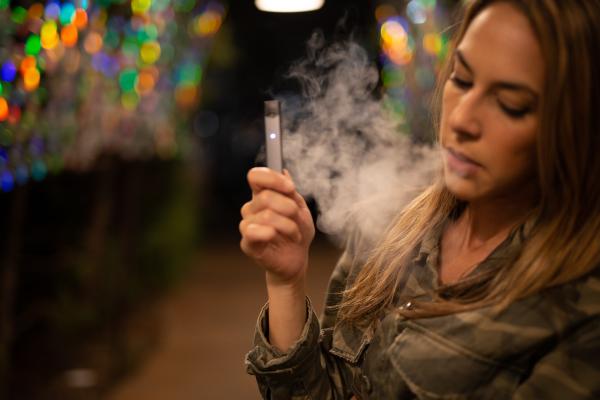The COVID-19 pandemic has spurred a new level of interest in lung health. As part of that trend, tobacco researchers and anti-smoking advocates are attacking electronic cigarette use (“vaping”) on the grounds that it could elevate your risk of coronavirus infection.
Writing in the Denver Post, Robin Deterding, medical director of the Breathing Institute at Children’s Hospital Colorado, outlined this argument in the context of teenage vaping:
[W]hile we know that COVID-19 is not as deadly to teens as it is to adults, particularly older adults, this pandemic is exacerbating an already concerning situation for Colorado teens — what the U.S. Surgeon General has named an epidemic — teen vaping.
Deterding is right to be concerned about teenage vaping. No child has any business using nicotine-containing products. But as we strive to protect our children, we have to reject conclusions drawn from flawed science and avoid counterproductive policies that could actually discourage smoking cessation. Unfortunately, Deterding wasn't able to do either in her column.
The COVID-vaping link
Deterding began her piece by citing a Stanford study that allegedly found a link between COVID-19 and vaping. “Among the study participants who were tested for COVID-19,” she wrote, “those who had used e-cigarettes were five to seven times more likely to be diagnosed with COVID-19 than those who did not use e-cigarettes.”
Without context, this statement doesn't tell us very much, so let's look at the study. The researchers conducted a survey of 4,351 young adults aged 13–24. The participants were roughly evenly divided into e-cigarette ever-users (50.2%) and nonusers (49.8%). The survey also categorized participants by past 30-day use of cigarettes only, e-cigarettes only, and dual use of e-cigarettes and cigarettes. Conclusion:
Ever-dual-users were seven times (95% CI: 1.98–24.55), ever-users of e-cigarettes only were five times (95% CI: 1.82–13.96), and past 30-day dual-users were 6.8 times (95% CI: 2.40–19.55) more likely to be diagnosed with COVID-19.
That's a striking finding, but we need to be aware of some limitations. All the data were self-reported, including positive COVID-19 tests and symptoms, which means there's no way to verify the information the researchers collected. They also didn't ask about the severity of symptoms, hospitalization, or how much each individual vaped or smoked. Past 30-day use would include someone who vapes daily as well as an individual who vapes once a month. These are significant gaps in the data if the goal is to understand the relationship between vaping and COVID-19.
What's arguably more troublesome is the authors' speculation about why vaping would boost the risk of infection by SARS-COV-2:
Heightened exposure to nicotine and other chemicals in e-cigarettes adversely affects lung function, with studies showing that lung damage caused by e-cigarettes is comparable to combustible cigarettes. COVID-19 spreads through repeated touching of one’s hands to the mouth and face, which is common among cigarette and e-cigarette users …
This makes little sense for several reasons. First, many studies, some of higher quality than this survey, have shown that vaping is probably far safer than smoking and unlikely to affect lung health. One small study, for example, found no difference in weight, blood pressure, heart rate, or lung function between e-cigarette users and non-smokers. Another showed that vaping improved chronic obstructive pulmonary disease (COPD) episodes and symptoms in smokers who quit or greatly reduced their use of cigarettes.
Second, the new study didn't report an increased risk of infection for cigarette-only smokers. The authors speculated that this is because teenagers are more commonly dual users of vaping devices and traditional cigarettes. But there are still underage only smokers in the US. If only vaping and dual use of e-cigarettes and traditional cigarettes are linked to greater COVID-19 risk, the study should have also detected a link between only cigarette use and COVID-19, which is much riskier than either of the former options, according to public health researcher Carl V. Phillips. Vaping "does not add to the risk of smoking because it almost always replaces some smoking rather than supplementing it," Phillips explained.
“The failure to find much of an association with smoking cigarettes compared to use of e-cigs is strange,” epidemiologist Geoffrey Kabat wrote in an email, “especially since they argue that smoking is a risk factor for COVID-19 (thru damage to the lungs).”
Third, a review of the relevant data from November 2020 found that "clear evidence of a higher susceptibility to SARS-CoV-2 infection due to smoking has not been established to date and this will need to be carefully examined in future epidemiological studies." [1] So, the assertion that vaping causes lung damage and thus increases coronavirus infection risk is tenuous, given that it hasn't even been established for smoking, which is likely far more harmful than vaping.
In any event, there may be a better explanation for the results, Kabat added:
The main thing that bothers me is that they make a leap from the observed associations to imply that it is exposure to e-cigs that increases the risk for developing COVID-19 … What appears to me to be more logical is that there is something about the social activity of vaping that is SOCIAL and involves contact with their peers, and, hence, increased likelihood of exposure to the virus.
Time to ban flavored e-liquids?
Deterding went on to advocate that flavored e-liquids be banned in Denver:
E-cigarettes are sold in over 15,000 flavors. I would argue that many of these flavored vape products — with flavors such as popcorn, grape and tropical slushy, as well as colorful packaging that looks like something you would get from an ice cream truck — are specifically targeted at teens.
Teenagers certainly like these flavors, but it's inappropriate to jump from that observation to the conclusion that e-liquids are intentionally marketed to children. The reality is that adults also like things that taste good; dozens of studies have shown that the wide variety of flavored liquids helps smokers permanently switch to vaping.
Given that research and thinking like a business owner for a moment, it makes sense that vape shops would offer lots of flavors to attract adult customers. The more important point from a public health perspective is that banning flavored e-liquids to protect children, 86.2 percent of whom don't use e-cigarettes, could encourage many thousands of ex-smokers to return to their deadly tobacco habit.
[1] Early on in the pandemic, a number of studies found that smokers were surprisingly underrepresented among patients infected with SARS-COV-2, leading some researchers to suggest this month that nicotine may offer a protective effect against infection. Still, nobody knows for certain yet.




